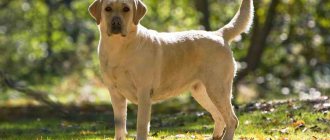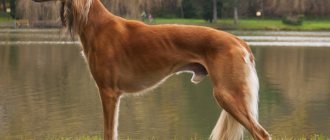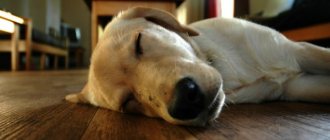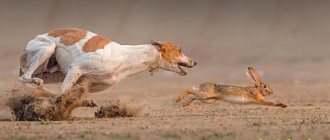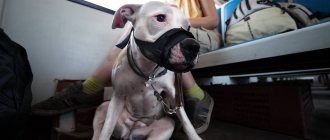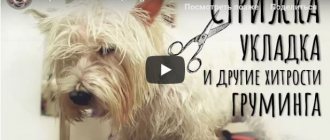Puppy training: where to start?
Before you demand anything from your dog, you need to remember a few simple rules:
- Study your pet's personality. Every dog is different and each needs an individual approach to enhance training.
- Clearly define the tasks that the dog must complete in the lesson.
- Develop certain gestures and signals that your dog should obey. Do not change them under any circumstances during the learning process.
- Reward each achievement of your pet with a small piece of treat.
- Try to make activities interesting for your dog. Play with her during breaks.
- Dogs get tired too. Don't delay your lessons.
In order for your dog to obey you and learn easily, you need to make friends with it . Your pet should trust you and not be afraid of anything. If you achieve this, you don't have to worry about training. It will be all plain sailing.
What benefits will you get from taking the Puppy Training course?
- Basic training makes life easier for you and your pet.
- Puppy training is a fun game in which both the pet and the owner receive development and training.
- After completing a full training course, your dog will become calm and self-confident, will trust you more, and you will trust it.
- You can gently control your pet and stop unwanted actions using basic commands.
- Daily obedience lessons will develop mutual trust and respect between you and your pet.
- Training contains the necessary elements for a puppy to live a full life: mental and physical exercise, providing the baby with “work” (to direct excess energy in the right direction), and, most importantly, spending time together so that the four-legged friend does not feel unnecessary due to the lack of your attention.
- When training a puppy to obey, a clear position is formed: The owner is the Leader of the pack family
who must be respected, obeyed and followed all his instructions. Proper upbringing will save you from the constant struggle with your pet for dominance in the family.
For training to be successful, basic commands must be practiced not only with a dog handler, but also independently, preferably daily. The puppy perceives training with him as a game, so it is necessary to maintain interest in learning every day. Change the tasks and location of the training - this will teach your pet to react correctly to your words and actions in different situations.
What problems can arise if you do not raise and train a puppy?
A dog has very developed natural instincts, and if it is not trained, the animal will become uncontrollable. Such a dog can destroy property, bark and howl for no reason, and behave aggressively towards family members, other people and animals. Also, the dog will constantly fight with the owner for the position of leader in the house and subordination of the family to himself.
If you want to avoid problem behavior, use the “Puppy Training” course, and your pet will respond to your attention with boundless love and tenderness!
By investing 1,500 rubles in 1 lesson, you will receive a well-mannered, happy and grateful pet!
Basic dog training methods
- Learning with voice. This method is the most famous. You need to teach your dog to respond to the sound of your voice. The pet must understand that if you say something, then your command must be followed by some action. Don't forget that dogs are good at distinguishing intonation. Train your voice. When you give a command, he should be even, calm and unemotional. Do not change the intonation for commands, then the dog will get used to it and begin to understand that he must obey when you speak in this particular tone. Never yell at the dog, otherwise you will get the opposite effect of the desired one.
- Clicker training. A clicker is a keychain with a clicking button. The click lets the dog know that he did exactly what he needed to do. To do this, you need to reinforce each click with a treat, then the pet develops a positive reflex to the clicker. This method prohibits the use of punishment. If the dog fails to follow the command, then you need to wait for the moment when he does everything correctly and praise him with a click and a treat.
- Training with force . If you decide to train your dog using this method, be sure to learn how to use the stimulus correctly. A jerk with a leash is usually used as a stimulus. Under no circumstances should jerking harm the dog! If the dog does not obey you when executing a command, then give a light tug first. If this still does not work, then strengthen it until the pet completes the command. There is no need to make a strong jerk. But excessive softness will not bring results. We must act harshly, but not cruelly. And don't forget about encouragement.
General obedience course for puppies
After understanding at what age to train a puppy, you can begin the initial stage of training. Initially, you should make it clear to the small pet that he is not a leader. This is the main goal for the first few weeks.
What you need to do for this:
- If there is disagreement, the puppy may try to bite the owner. This is where you need to raise your voice and let him know that this is unacceptable. For example: “Jack, you can’t!”, “Jack, stop!” and so on, accompanying the word with a slap. If he doesn’t stop, you need to hit him a little harder and say it even louder.
- If a small husky, terrier or other breed of dog is lying where it shouldn't, you need to loudly drive it away from there, accompanied by a small spank with a wet towel. It doesn't hurt, but it will feel unpleasant. Then you need to invite him to lie down in his place in a pleasant voice, after completing the command, stroke him and reward him with a treat.
- There is no need to feed your pet from the table.
- Instill the skill of calm response during examination. If the puppy behaves calmly, you need to reward it. If he doesn’t obey, you need to shake him slightly by the withers, and then continue the inspection.
- Command "Near!" will help the puppy to get ready and always be under control, not to break out when leaving the apartment and the entrance to the street. To do this, you need to pull the leash when trying to break free and speak the command loudly.
Additional Information! The owner's love and patience, coupled with adequate training, will help establish contact with the pet.
After a few weeks, the puppy will begin to get used to the commands.
Each time the puppy will begin to take commands more seriously and more attentively
What is included in the obedience course
Basic training includes basic commands such as “come”, “near”, “fu”, “sit”, “down”. It is needed so that you can control the dog in any situation.
Also, the basic course is aimed at developing the skills necessary for further teaching the dog more serious commands that will make your friend a real protector.
Basic commands:
- "To me" . The most important command that allows you to keep your pet away from other dogs, cats and people. It also eliminates the need to catch up with a runaway dog.
- "Place" . This command is useful when you need the dog to stay out of the way and sit quietly in its corner, for example, if you are cleaning.
- "Ugh" . The pet should not chew foreign objects and the skirts of women passing by. So this team is vital.
- "Near" . Any dog should be able to walk correctly next to its owner. Without this command, you simply cannot go outside for a walk: the dog will not allow anyone passage.
- "Walk" . When you give the command, let your pet off the leash. It is better to do this in a place where an untrained dog will not harm anyone.
- "Sit" and "lie down" . Usually used when traveling on public transport. Or when the dog has to wait for you for a long time.
- "It is forbidden" . Don't let your dog bark for no reason, beg for food, or snap at you. This command is needed precisely in such cases.
- "Face" . Any dog will always protect its owner. But she may draw the wrong conclusions and try to attack the wrong person. Train your dog to protect you when necessary.
Life with a dog in comfort and safety
Policy regarding the processing of personal data
1. General Provisions
This personal data processing policy has been drawn up in accordance with the requirements of the Federal Law of July 27, 2006. No. 152-FZ “On Personal Data” and determines the procedure for processing personal data and measures to ensure the security of personal data bobig.ru (hereinafter referred to as the Operator). The Operator sets as its most important goal and condition for carrying out its activities the observance of human and civil rights and freedoms during processing his personal data, including the protection of rights to privacy, personal and family secrets.
This Operator’s policy regarding the processing of personal data (hereinafter referred to as the Policy) applies to all information that the Operator can receive about website visitors
2. Basic concepts used in the Policy Automated processing of personal data – processing of personal data using computer technology;
Blocking of personal data – temporary cessation of processing of personal data (except for cases where processing is necessary to clarify personal data);
Website – a collection of graphic and information materials, as well as computer programs and databases that ensure their availability on the Internet at a network address;
Information system of personal data - a set of personal data contained in databases, and information technologies and technical means that ensure their processing;
Depersonalization of personal data - actions as a result of which it is impossible to determine without the use of additional information the ownership of personal data to a specific User or other subject of personal data;
Processing of personal data – any action (operation) or set of actions (operations) performed using automation tools or without the use of such means with personal data, including collection, recording, systematization, accumulation, storage, clarification (updating, changing), extraction, use, transfer (distribution, provision, access), depersonalization, blocking, deletion, destruction of personal data;
Operator - a state body, municipal body, legal or natural person, independently or jointly with other persons organizing and (or) carrying out the processing of personal data, as well as determining the purposes of processing personal data, the composition of personal data to be processed, actions (operations) performed with personal data;
Personal data – any information relating directly or indirectly to a specific or identifiable User of the website;
User – any website visitor;
Providing personal data – actions aimed at disclosing personal data to a certain person or a certain circle of persons;
Dissemination of personal data - any actions aimed at disclosing personal data to an indefinite number of persons (transfer of personal data) or familiarizing with personal data to an unlimited number of persons, including the publication of personal data in the media, posting in information and telecommunication networks or providing access to personal data in any other way;
Cross-border transfer of personal data – transfer of personal data to the territory of a foreign state to an authority of a foreign state, a foreign individual or a foreign legal entity;
Destruction of personal data - any actions as a result of which personal data is destroyed irrevocably, with the impossibility of further restoration of the content of personal data in the personal data information system and (or) as a result of which, material media of personal data are destroyed 3. The Operator can process the following personal data of the User Last name, Name Patronymic name; Email address; Phone numbers;
The site also collects and processes anonymized data about visitors (including cookies) using Internet statistics services (Yandex Metrica and Google Analytics and others).
The above data below in the text of the Policy are united by the general concept of Personal Data.
4. Purposes of processing personal data The purpose of processing the User’s personal data is the conclusion, execution and termination of civil contracts; providing the User with access to services, information and/or materials contained on the website.
The Operator also has the right to send notifications to the User about new products and services, special offers and various events. The User can always refuse to receive information messages by sending the Operator an email to the email address marked “Opt-out of notifications about new products and services and special offers.”
Anonymized data of Users, collected using Internet statistics services, serves to collect information about the actions of Users on the site, improve the quality of the site and its content.
5. Legal grounds for processing personal data The Operator processes the User’s personal data only if it is filled out and/or sent by the User independently through special forms located on the website. By filling out the appropriate forms and/or sending his personal data to the Operator, the User expresses his consent to this Policy.
The Operator processes anonymized data about the User if this is allowed in the User's browser settings (saving cookies and using JavaScript technology are enabled).
6. The procedure for collecting, storing, transferring and other types of processing of personal data
The security of personal data processed by the Operator is ensured by implementing legal, organizational and technical measures necessary to fully comply with the requirements of current legislation in the field of personal data protection.
The operator ensures the safety of personal data and takes all possible measures to prevent access to personal data by unauthorized persons.
The User's personal data will never, under any circumstances, be transferred to third parties, except in cases related to the implementation of current legislation.
If inaccuracies in personal data are identified, the User can update them independently by sending a notification to the Operator to the Operator’s email address marked “Updating personal data.”
The period for processing personal data is unlimited. The User may at any time withdraw his consent to the processing of personal data by sending a notification to the Operator via email to the Operator's email address marked “Withdrawal of consent to the processing of personal data.”
7. Cross-border transfer of personal data
Before the start of cross-border transfer of personal data, the operator is obliged to ensure that the foreign state into whose territory it is intended to transfer personal data provides reliable protection of the rights of personal data subjects.
Cross-border transfer of personal data to the territory of foreign states that do not meet the above requirements can only be carried out if there is written consent of the subject of personal data to the cross-border transfer of his personal data and/or execution of an agreement to which the subject of personal data is a party.
8. Final provisions
The user can receive any clarification on issues of interest regarding the processing of his personal data by contacting the Operator via email [email protected]
This document will reflect any changes to the Operator’s personal data processing policy. The policy is valid indefinitely until it is replaced by a new version.
The current version of the Policy is freely available on the Internet at .
Let's start training your dog
First of all, the dog is trained to the place. They do this, of course, at home. We also teach the pet the “come to me” command when we call him to eat. Be sure to call him by his nickname, he should respond to it. After this, at home we teach the dog the commands “sit”, “lie down”, “fu”, “no” and others.
Problems usually arise when the pet goes outside. If he obeyed you at home, then outside his walls, intoxicated by sudden freedom, he may behave unpredictably. In general, training a dog at home and outdoors are two different things. At first, you definitely won’t be able to do without a leash.
time for training , the main thing is that it is not hot outside. Stock up on plenty of treats, take water, and find a quiet corner to keep your dog as little distracted as possible.
The first classes should last no more than half an hour , gradually increase their duration to an hour or an hour and a half. Spend no more than twenty minutes learning one command, otherwise your pet will get bored. Give the dog a short walk and move on to the next one. Try to mix up the order of learning commands every day - this has a positive effect on the effectiveness of learning.
Dog training: review of useful video
Animalcity presents its readers with a review of educational materials on raising and training a dog. We found several lessons for you that we thought were worthy of attention, and we invite you to see what professional instructors teach dog lovers and novice trainers. We are sure that this knowledge will be useful to you and will help you establish complete mutual understanding with your four-legged friend!
Don Sullivan
VIDEO Secrets of raising the perfect dog
When training dogs, the instructor recommends using a training collar of your own design or a strict metal one. Don suggests training a dog using rewards (voice, stroking) and punishments (impact with a collar). The trainer advises to accompany voice commands with gestures - thanks to such reinforcement, it will be easier for the dog to understand what you want from it.
This helpful 5-hour video contains tips on how to teach a dog to wait for its owner (for example, outside a store), and also gives examples of daily “in between” training. Here you will find tips on how to rehabilitate a dog that breaks from its leash during a walk, and how to deal with aggression and the dog’s reluctance to obey your commands. Sullivan tells how to overcome a dog's stubbornness, even if you have managed to spoil it, and how to show that you are the leader in your couple.
WalkService Professional Dog Training School
VIDEO OKD dog training: fetching, first part
In a series of training videos by Alexey Potekhin, a training strategy is described, which consists of observing the dog, establishing contact and developing useful reactions. The main thing is to explain to the dog what behavior will be rewarded and establish control.
An important point is managing the dog’s attention and concentrating on the trainer. The instructor advises using exercises with a toy to practice concentration. A toy that is interesting for a dog can replace food and can serve as a reward for correctly following commands. This is the booty that the dog will receive for “good behavior.” The video shows different ways to work with the toy.
In this lesson you will also learn how the prey motive helps you begin to train your dog to protect from puppyhood. The trainer focuses on key points, points out mistakes to avoid, and warns about the dangers of some exercises for novice trainers.
“Your own dog handler”
Knowledge Center and Virtual Training Center
VIDEO Stages of training a puppy - the most important
Irina Bezuglaya in this video lesson compares training a dog with teaching a child to write. Just as any schoolchild goes from squiggles to dictations and essays, so a dog first learns the basic correct reactions: following a hand, concentrating on the owner - and gradually develops more and more clear behavior in response to a command. And only after a while, having completed a course of general training, the dog acquires a “specialty” - works for protection and security or learns behavior in the ring.
A series of educational videos provide the basics of working with a dog at an early age: how to accustom a dog to a collar and leash, teach the basic commands “Sit!” and “Come to me!”, how to properly punish a puppy to avoid mistakes in initial training.
VIDEO The dog does not hear commands in front of dogs!
The video tutorial offers a solution to the problem of dog disobedience when there are distractions (working in a noisy city, with other dogs). To clearly practice a command, it is necessary to go through three stages of training: 1) getting to know the command, developing the correct reaction with the help of reinforcement with a treat; 2) replacing food rewards with play, praise, or communication; 3) gradual introduction of distractions.
Team "Azart"
VIDEO First steps in obedience, part 1
The first part of the video “First Obedience Lessons” shows the method of working with a 2-3 month old puppy and includes training in moving nearby, performing commands “Come to me!” and “Lie down!” There is no voiceover in the lesson, but the most important points are clearly described on text slides. In the 2nd and 3rd parts of the video, the complexity of the commands increases in proportion to the age of the dog.
The series also contains lessons on fetching, sending forward, overcoming barriers, and tracking work. Classes are shown for puppies from 1.5 months of age to 4–5 months and older.
Universal training center Gelion
VIDEO Initial puppy training. First steps
Link to video
Video lessons from the Gelion center are devoted to the initial training of puppies, as well as applied and sports training. Instructor Vitaly Golota, together with the baby Caucasian Shepherd Chani, in the first lesson shows how to practice concentrating on the trainer, explains the meaning of the “Yes” and “No” markers, tells what a “target hand” is and why you need to teach the puppy to follow it .
The series of lessons also includes the “Crash Test” section - it examines in detail the mistakes that owners most often make when working with dogs, and gives advice on how to avoid these mistakes. The purpose of training is not only to teach a dog to obey and educate it, but also to establish mutual understanding, to establish a deep connection that will allow a person and a dog to understand each other perfectly.
Good luck and patience in training your beloved pets! If you have other useful training materials, don’t be greedy, share the link with Animalcity and other readers! Comments are welcome!
Useful tips from professionals
- Before you begin training your dog outside, let him become familiar with the area. This way she will feel calmer and training will be easier.
- It is also useful to let your dog run before class. Tired, she will concentrate better on commands, which will greatly simplify the learning process.
- There is no need to repeat the command five times in three seconds, otherwise your pet will get confused.
- Make sure that all commands are carried out with pleasure and without fear. If you notice that your dog is scared, then most likely you were too strict. Stop training to let your pet calm down. The next day, start again, making everything a little softer.
- Gradually make things more difficult. The dog should obey you not only in a quiet place, but also in case of unforeseen situations.
- Make sure the dog obeys all family members.
City Dog Management (UDS)
The need for the emergence of puppy training courses for UGS is dictated by time, and is aimed at user dogs, and not at sports dogs. They instill obedience in the dog, adapt it to the urban environment and make it safe for others.
During UGS, the dog practices commands such as: “Sit”, “Lie down”, “Next to me”, “Come to me”. She is accustomed to city noise, muzzled, and weaned from taking food from strangers and from the ground.
The UGS course is designed for 10 - 16 trainings, the age of dogs that are allowed for training is at least 15 months. Upon completion of the course and after testing, a diploma is issued.
As you can see, there are many dog training courses, and not every pet is able to undergo training in all programs, and there is no point in doing so. When choosing a course, you should start from the dog’s capabilities and its purpose. OKD is mandatory for the comfortable existence of the owner and pet, the rest depends on your desire.

